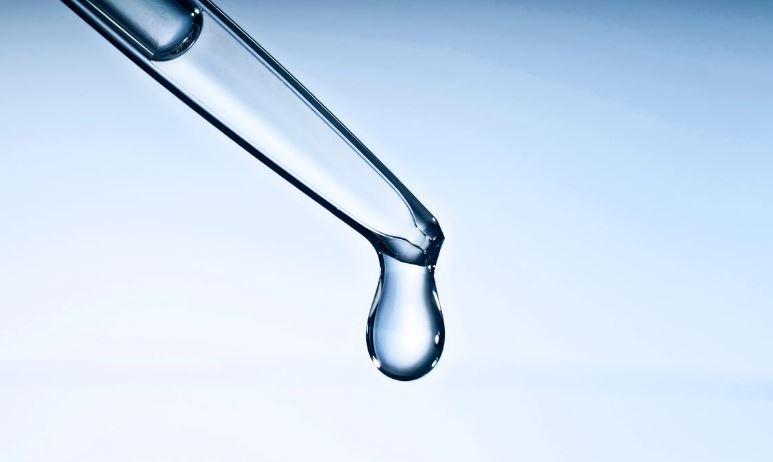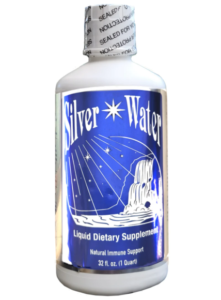For thousands of years, silver has been used medicinally, as an antibiotic, antiseptic, biocide, fungicide, microbe and pathogen killer, sanitizer, and viricide. Silver has a profound effect on over 650 different organisms that are harmful or potentially dangerous to the human body.
Silver prevents the growth and replication of bacteria, by penetrating its protective layer and scrambling the harmful bacteria’s contents, rendering it harmless until it dies then the bacteria’s remains are disposed of via the excretory system.
Silver is a natural way to keep pathogens from surviving and multiplying in moist environments, which increases the human immune response, providing a healthier balanced physical experience.
Silver’s Health-related Benefits
- Anti-inflammatory
- Anti-microbial
- Enhances intestinal microbiome
- Natural immune support
- Does not build up in tissues
- Does not interfere with antibiotics or good bacteria
The two Forms of silver solutions are colloidal and Ionic
The two forms of liquid concentrated silver are colloidal silver or ionic silver, and they are different, for instance,
Colloidal Silver
You will find colloidal silver products abound throughout the marketplace. Colloids are particles that have been reduced in size. These small particles are called colloidal particles. When these colloidal particles, such as colloidal silver particles, are suspended in liquid, the resulting mixture is called colloidal followed by the name of the particles that were reduced. In the case of silver, the result would be colloidal silver.
The density of silver colloids in any liquid would be measured by parts per million or PPM.
Colloid particles are not water soluble and are somewhat unstable. In the case of silver, the colloids could fall out of suspension and gather together, even form a cluster inside the container holding such a mixture.
One may do a visual inspection of the liquid to check for particles which have fallen from suspension and gathered together. You will notice this by looking at the sides or the bottom of the container when the container is backlit by a light source.
Colloidal solutions possessing colloids that have fallen out of suspension could have passed their expiration date or may have been manufactured by less than professional standards. Additionally, these solutions may have been made with negatively charged particles or particles that are electrically neutral (have no charge at all).
Ionic Silver
Then there are the ionic silver solutions. In contrast to colloidal silver which is made of silver particles, ionic silver is made from silver ions suspended in liquid. Silver ions are atoms of silver less one electron giving it a positive electrical charge. This is what imbues its capability to disrupt the enzyme activity in pathogens, such as, harmful bacteria, germs, yeasts, viruses, and parasites.
Atomic silver ions are water soluble, whereas silver colloids are not. Being able to be dissolved in solution increases the bioactivity of the ion exponentially. The density of an ion is far less than that of a colloid. Therefore, when density is measured in parts per million (PPM), the resulting number can be very low, but many times more powerful than the colloid, so you can do so much more with far less ionic silver.
Biomolecules, including DNA, enzymes, intracellular contractors, and membranes of harmful bacteria, are easily penetrated and affected by the bioabsorbable silver ion. It is this unique action that makes ionic silver such a powerful antimicrobial agent.
In scientific side by side comparisons, silver ions were proven to be 7,665 times more effective than silver colloids.
What to look for when buying colloidal silver?
When considering buying any colloidal silver product, it is recommended that you review the data of a particular brand answering the following questions:
- Are the silver ions positively charged?
- Is the silver bio-active and bioavailable?
- What is the percentage of silver purity?
- What is the size of the particles in the solution?
- How many parts per million (PPM) of silver is in the solution?
Concerning Purity of Silver
Purity represents the highest silver content from which the product is manufactured. This will determine the purity of the end product if manufactured in a professional manner. 99.99% pure silver or higher is considered pure as silver cannot be refined to 100%. The best products will have 99.99% or more silver.
Silver Particle Size
Size matters in terms of silver particle size. A large particle might sound impressive, as might a high parts per million (PPM) concentration, but in terms of bioavailability and increased efficacy, the smaller the better.
There is a direct correlation between smaller silver particle size and absorbability. Atomic-sized particles are as small as you can get, which enables the silver ion to decimate the microscopic bad players threatening your otherwise healthy biology.
Also, smaller silver particles mean there is better consistent coverage of an area requiring treatment increasing biological activation.
PPM (Parts Per Million)
Silver formulas can be misleading in terms of parts per million concentrations. When considering colloidal silver, the higher the concentration of silver the more effective it will be. Because colloids are large in size it takes more of them to treat any given area.
Silver ions are approached from a different perspective. Due to their small size (atom-sized is as small as you can go), their molecular weight is of little significance because they outnumber colloidals thousands of times. So, a smaller, say, PPM of silver ions will still have many times more active silver than 100 PPM of colloidal silver.
Will Silver Turn My Skin Blue?
There is a rare condition that goes by the name of argyria, which does cause discoloration of the skin pigment that will appear blue/gray in color. An overabundance of silver salts in the body is usually the culprit.
Homemade silver solutions can host too many large-sized silver particles that aren’t as easy to pass through the excretory system. When the body lets them take up residents in tissues, it can build up toxicity levels of silver that can lead to argyria, which can turn your skin blue/gray.
Even though this is also referred to as, “silver poisoning from an overdose of silver,” there are no negative health side effects. Only skin discoloration, which is undesirable.
The small size of silver ions allows them to pass through the body relatively quickly, usually 6 to 9 hours. It just does its work and passes through, not setting up housekeeping in the body.

